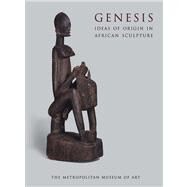Genesis Ideas of Origin in African Sculpture
, by LaGamma, Alisa- ISBN: 9780300199871 | 0300199872
- Cover: Paperback
- Copyright: 6/25/2013
Since earliest human history, peoples around the globe have pondered their origins: Where do we come from? How did the world begin? In grappling with these fundamental questions, we developed a myriad of theories concerning our beginnings. "Every community in the world," according to historian Jan Vansina, "has a representation of the origin of the world, the creation of mankind, and the appearance of its own particular society and community." In many African cultures, these exalted ideas of "genesis" have been made tangible through rich expressive traditions interweaving oral history, poetry, and sculpture. This volume, which accompanies an exhibition at The Metropolitan Museum of Art, New York, examines the staggering variety of ways in which African sculptors have given expression to social ideas of origin, from the genesis of humanity to the historical sources of families, kingdoms, agriculture, and other essential institutions. The seventy-five masterpieces presented here, drawn from public and private American collections, are among the most celebrated icons of African art, works that are superb artistic creations as well as expressions of a society's most profound conceptions about its beginnings. All are reproduced in color and are accompanied by entries that illuminate the distinctive cultural contexts that inspired their creation and informed their appreciation.
Part I surveys a broad spectrum of African sculpture from across the continent and in a range of media. The Senufo peoples of Côte d'lvoire and Mali, for example, commemorate divine creation with large-scale carved wood figural pairs representing the primordial couple, the first man and woman. Among the Yoruba of Nigeria, the notion that humanity was modeled from clay at the beginning of time is evoked by sublime, antique terracotta busts. In the Democratic Republic of the Congo, a triptych of lavishly appointed, beaded masquerades reenacts a story of original sin and the source of Kuba kingship. The common desire to memorialize and exalt founding ancestors is reflected in numerous works, from boldly abstract zoomorphic masks from Burkina Faso to idealized figurative forms made across central Africa.
Part II focuses on Africa's best-known sculptural genre, the ci wara headdresses of the Bamana peoples of Mali. The headdresses take their name from the mythological hero Ci Wara, who introduced the art of agriculture and an understanding of the earth, plants, and animals to the Bamana. To commemorate this vital contribution to human sustenance, the Bamana instituted a tradition of ceremonial dances in which Ci Wara was represented by costumes crowned with intricately carved wood headdresses. These sculptural elements have long been admired in the West for their elegant refinement and inventive abstraction. They often integrate the features of symbolic animals—possibly the antelope, aardvark, and pangolin—into graceful, endlessly dynamic designs. In her introductory essay, Alisa LaGamma considers the ci wara tradition in all its nuanced complexity and reveals some of the less well-known regional and individual interpretations of the genre. She also provides an art historical overview of the theme of "genesis" and suggests ways of understanding African artistry from this perspective. [This book was originally published in 2002 and has gone out of print. This edition is a print-on-demand version of the original book.]







